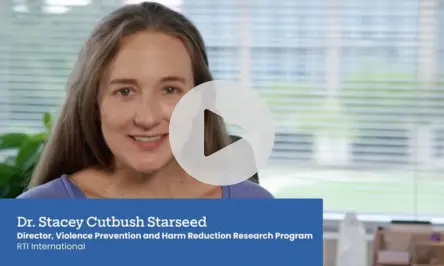An objective, comprehensive outcome evaluation tool standardizes assessments among survivors of human trafficking engaged in programs and services
Human sex and labor trafficking is a complex human rights issue that occurs within multiple industries and involves adults and children of any age, sex, gender identity, or citizenship. As a result, numerous programs and services exist to aid survivors (referred to as clients when receiving case management services) in various areas of recovery. However, while federal funding for these programs has increased nearly tenfold in the last decade and continues to grow, little is known about how effective these service portfolios are in terms of their impact on the lives of the clients they aim to serve.
Defining outcomes for human trafficking victims is challenging because the harm and disruption that trafficking causes is multifaceted and can impact physical and behavioral health, employment, education, self-sufficiency, and more. Because of this, success looks different for each client as they heal and recover. Further, programs are often limited in their ability to report outcomes efficiently due to limited organizational capacity, time constraints, and challenges managing and analyzing data, among others.
Partnering with experts to create an evidence-based, survivor-informed evaluation tool
The National Institute of Justice is dedicated to combatting human trafficking issues and recognized the need for a standardized way to report client outcomes. Through NIJ grant funding, RTI developed the Outcomes of Human Trafficking Survivors instrument (OHTS): a free, Microsoft Excel-based tool that case managers can use to objectively and comprehensively evaluate outcomes among human trafficking survivors. The tool can also be used to evaluate program effectiveness and document impact.
To develop this tool, we began by reviewing prior research and existing tools designed to assess human trafficking outcomes. We then assembled a team of researchers at RTI and expert panels of survivors, researchers, and service providers, including the Coalition to Abolish Slavery and Trafficking (CAST), which had previously developed an outcomes reporting assessment that we used as a starting point for our instrument development process.
These partnerships provided important perspectives that helped us determine what outcomes should be measured, how they should be measured, and how to create an instrument that was user-friendly in order to facilitate consistent reporting across case managers and programs. Input from survivors was crucial as we aimed to ensure that the instrument reflected their diverse experiences.
Providing a comprehensive measure of client outcomes and goals over time
The OHTS instrument is the product of rigorous research informed by literature reviews, interviews, surveys, cognitive testing, and validity and reliability testing. The instrument is used without the client present to minimize client burden. It captures outcomes in 14 categories spanning four domains: safety, well-being, social connectedness, and self-sufficiency. Importantly, the tool is applicable to domestic or foreign national adults and minors who have experienced sex and/or labor trafficking. This integrated approach allows the OHTS instrument to be used in assessments of clients of diverse ages, genders, nationalities, experiences, and goals.
Case managers can repeat evaluations at regular intervals, allowing them to identify changes in client priorities, strengths, and vulnerabilities over time.
Client assessments can also be used on a broader scale to evaluate programs themselves, allowing program directors to identify gaps in program services, demonstrate impacts to stakeholders, and contribute findings on successes and challenges to the field of human trafficking services provision.
Standardizing reporting across scales
As of March 2023, the OHTS has been downloaded over a thousand times since it was launched in 2020. Most users have reported using the OHTS for program evaluation and case management, with a sizeable proportion also using the tool for research purposes. Users also reported a variety of funding supporting their human trafficking work, from federal and state agencies to local sources and foundations.
Ultimately, use of the OHTS can improve our understanding of effective programs and services, helping to inform practice and policy decisions that ensure that all survivors receive high quality, comprehensive care.
Access the free OHTS instrument and the accompanying user guide, which provides technical specifications and instructions. For more information about what the OHTS measures and how it was developed and tested, see the development brief.
Learn more about RTI's human sex and labor trafficking research.
- National Institute of Justice




